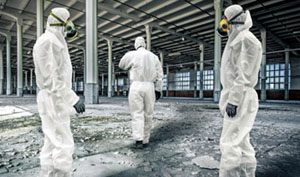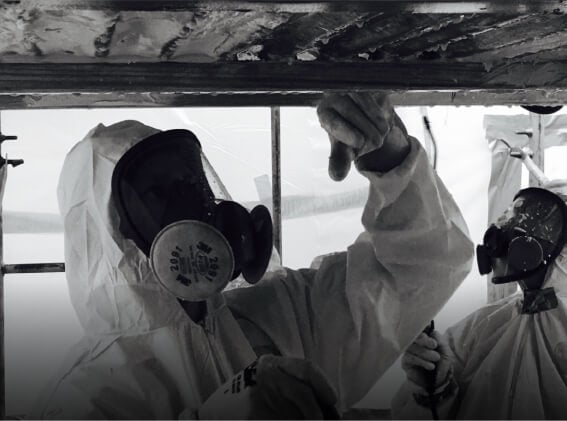The Complete Refine of Accredited Asbestos Examining to Make Certain Home Compliance
In the world of home monitoring and compliance, the procedure of accredited asbestos testing stands as a crucial component to guarantee the security and wellness of passengers. From the preliminary evaluation to the final interpretation of results, each stage plays a crucial duty in determining the presence of asbestos within a residential property.
Accredited Asbestos Testing: Initial Assessment
In conducting the first evaluation for certified asbestos testing, a careful assessment of the residential or commercial property's materials is imperative to precisely identify prospective asbestos-containing materials. Special interest is offered to products that are prone to harm or disruption, as these circumstances can launch harmful asbestos fibers right into the air.
Accredited asbestos assessors comply with strict protocols established by governing bodies to make certain the precision and reliability of the testing procedure. By meticulously documenting findings and utilizing sophisticated testing techniques, assessors can give building owners with a comprehensive report outlining the existence of asbestos, if any, and the suggested steps for reduction or elimination. This preliminary assessment sets the structure for succeeding actions to address asbestos issues and guarantee the safety and compliance of the building.
Example Collection Procedures for Asbestos Examining
Reliable sample collection procedures are necessary in ensuring exact asbestos testing results and compliance with governing requirements. When collecting examples for asbestos screening, it is vital to comply with rigorous protocols to decrease the danger of contamination and make certain the reliability of the outcomes.
First of all, it is very important to identify the thought asbestos-containing products (ACMs) and prioritize tasting locations based upon factors such as the product's problem, ease of access, and capacity for disturbance. Asbestos Testing. Examples must be collected from various places within the building to supply a detailed assessment of asbestos existence
During sample collection, accredited experts need to use suitable individual safety equipment (PPE) to safeguard versus asbestos exposure. They need to make use of clean tools, such as non reusable handwear covers and plastic sheeting, to avoid cross-contamination in between samples. Samples must be meticulously accumulated utilizing a specified method, such as wet cleaning or coring, and firmly secured in closed containers to maintain their stability during transportation to the research laboratory for evaluation.
Laboratory Analysis Process for Asbestos Samples
Upon completion of the sample collection process, the asbestos samples are thoroughly carried to certified research laboratories for careful evaluation. The first action in the lab evaluation process is example preparation, where the gathered examples are meticulously processed to remove the asbestos fibers.

Once the analysis is complete, an in-depth report is generated, describing the findings and verifying whether asbestos exists, the type of asbestos fibers recognized, and the focus levels. This info is critical for homeowner to take the essential steps to make certain compliance with asbestos laws and safeguard the health of passengers.

Reporting and Analysis of Asbestos Examination Outcomes
Approved asbestos testing labs offer comprehensive reports that supply vital insights into the presence, kind, and concentration levels of asbestos fibers discovered in examples accumulated from properties. These records are necessary for homeowner and supervisors to understand the risk postured by asbestos and make notified choices regarding its administration or removal. The records generally consist of information on the techniques used for testing, the locations where examples were taken, the sort of asbestos determined (such as chrysotile, amosite, or crocidolite), and the concentration degrees of why not check here asbestos fibers detected.
Translating these results needs knowledge to assess the prospective health and wellness threats connected with asbestos direct exposure, establish the ideal training course of activity, and guarantee regulatory conformity (Asbestos Testing). Depending on the findings, suggestions might range from proceeded monitoring and maintenance to encapsulation or full asbestos reduction. Homeowner need to thoroughly evaluate these reports and seek advice from asbestos experts to create an extensive plan for attending to any asbestos issues recognized
Guaranteeing Building Compliance With Asbestos Regulations
To keep adherence with asbestos policies, property owners must vigilantly carry out measures to guarantee compliance with applicable laws and standards. When asbestos is identified, residential property owners have to comply with asbestos monitoring plans that synopsis appropriate control, elimination, or encapsulation procedures to avoid exposure and spread of asbestos fibers.
Property owners should give asbestos understanding training to staff members and residents to minimize the threat of asbestos exposure and make sure proper handling of products that may have asbestos. Furthermore, it is essential to stay notified about any type of updates or adjustments in asbestos guidelines to readjust management methods accordingly. By proactively resolving asbestos conformity requirements, homeowner can create a secure environment for owners and alleviate potential legal and health risks connected with asbestos exposure.
Verdict
Finally, certified asbestos testing is a critical process for making sure residential or commercial property compliance with policies. The preliminary analysis, example collection procedures, lab analysis, and interpretation of results are very important action in this process. By complying with these procedures, residential property click here for more info proprietors can recognize and attend to any kind of asbestos dangers existing, protecting the health and wellness of occupants and maintaining compliance with governing demands.